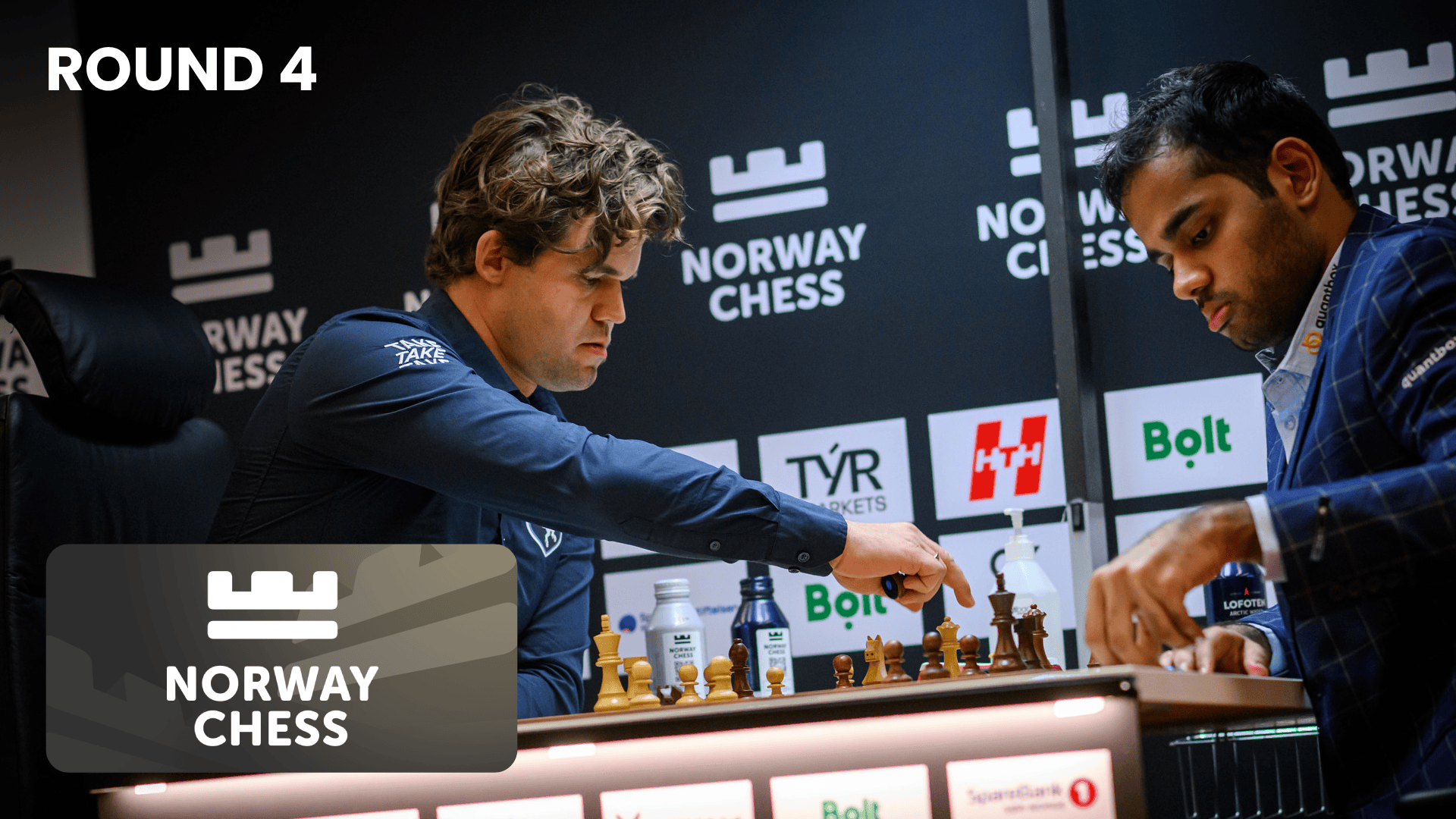GM Magnus Carlsen scored a smooth win over GM Arjun Erigaisi in round four of Norway Chess 2025 to take the sole lead after GM Fabiano Caruana missed a classical win over GM Gukesh Dommaraju. The relieved world champion stormed to an armageddon win on his birthday, while GM Wei Yi also beat GM Hikaru Nakamura in armageddon, meaning he’d defeated the world numbers one and two on consecutive days.
Although they both lost their armageddon games (against GMs Ju Wenjun and Vaishali Rameshbabu respectively), GMs Koneru Humpy and Anna Muzychuk still lead Women’s Norway Chess 2025. After resilient defense, IM Sara Khadem took advantage of GM Lei Tingjie’s blunder to score the only classical win of the day and her first win of the tournament.
Round five starts Saturday, May 31, at 11 a.m. ET / 17:00 CEST / 8:30 p.m. IST.
Norway Chess Round 4 Results
Carlsen and Khadem were the only players to pick up a full three points for classical wins in round four, while Gukesh, Wei, Ju, and Vaishali got 1.5 points for winning in armageddon.
Open: Carlsen Takes Lead As Gukesh Escapes Vs. Caruana
Women: Humpy, Muzychuk Still Lead; Khadem Gets Back On Scoreboard
Round 5 Pairings
Open: Carlsen Takes Lead As Gukesh Escapes Vs. Caruana
After two frustrating days of classical misses and armageddon losses, Carlsen has taken the sole lead by defeating Arjun.
Norway Chess Standings After Round 4
Carlsen 3-0 Arjun
Six-time Norway Chess Champion Carlsen has now beaten both Indian top-five stars Gukesh and Arjun in this year’s event, but when asked whether he had more motivation to beat the youngsters he noted things could have gone differently:
It’s a little bit random that I happen to have beaten Gukesh and Arjun so far, seeing that I’ve really had pressure against everybody, but still, I’m kind of trying to beat them all! I think you could see certainly inexperience in his defense today, which worked out in my favor.
I’m kind of trying to beat them all!
—Magnus Carlsen
Carlsen played the English Opening against Arjun and was happy with the outcome, but less with the speed at which he was playing.
Later he would explain his hesitation as being down to the number of choices he faced in an unfamiliar position, but he soon found clarity, sped up, and picked up a pawn. The position should still have been within the drawing margins for Black, but Carlsen was very familiar with the process that followed. He summed up Arjun’s dilemma: “You get presented with more and more difficult choices and eventually you go wrong.”
Carlsen even guessed the moment at which it would happen, visiting the confessional as Arjun thought for 15 minutes on move 30.
Carlsen explained that 30…Qe7, swapping off queens, should be a draw, while allowing the trade of a pair of rooks would be fatal. It was the latter scenario, as Arjun opted for 30…Re6?.
There was no way back as Carlsen, with all the time in the world, brought the game to its logical conclusion.
GM Rafael Leitao has analyzed our Game of the Day below:
That gave Carlsen the lead, but he would have been overtaken if Caruana had beaten Gukesh in classical chess. It was a close-run thing!
Gukesh 1.5-1 Caruana
Gukesh had beaten Nakamura the day before shortly after midnight in India, so that 19th birthday congratulations were already incoming. His full birthday, however, was on the day of round four, with Gukesh later explaining that he gets no pleasure from playing on his birthday:
Most of my birthdays I end up losing the game, so glad it did not repeat in the classical. When I was playing I felt fine, but when I was losing I was like, ok, not again!
Most of my birthdays I end up losing the game!
—Gukesh Dommaraju
The opening caught the eye of Nakamura, who noted, “Gukesh sacrificed a pawn to get the bishop pair,” which he felt was an AlphaZero-style move and showed a “stylistic shift” in how the new generation understands the game.
The computer approves, but in the play that followed the older wisdom that “a pawn is a pawn” came ever more into play, as Gukesh’s compensation evaporated and he found himself simply down a pawn in a very tricky position. Add in the unforgiving time control in Stavanger—no time is added at move 40, with only a 10-second increment per move kicking in—and the situation became dire.
The good news for the world champion, however, was that time was also a factor for Caruana, and things weren’t clear-cut. He explained, “I was just trying to make some moves not to lose on the spot because it just looked so bad, but I also found it hard to see any direct killer blow for him.” The moment when the computer claimed a win for Caruana was after 48.Qf4?!, which Gukesh played with eight seconds on his clock.
Caruana needed to keep the queens on the board with 48…Qd4!, when he could then up the pressure by pushing his h-pawn or bringing a knight to a4. Instead, Caruana swapped off queens and made one inaccurate knight move and suddenly the advantage had gone.
Gukesh knew he’d dodged a bullet, but things would soon turn fully his way: “The classical game could have easily gone bad, but luckily I managed to save it in the time scramble, and then the armageddon was very good!”
Gukesh had White for the armageddon and, in a must-win situation, went for a b3 and Bb2 system. It worked to perfection, and he noted, “after I got the 14.Nd5! shot in it’s already quite pleasant for me.”
Gukesh had more than survived his birthday, with a classical win, a classical draw, and an armageddon win!
One more matchup would go to armageddon in the Open tournament.
Nakamura 1-1.5 Wei
When Wei won this clash it meant he’d beaten the world numbers one and two in consecutive rounds and, understandably, he was happy!
I feel so happy. My opponent is world number-two and I was black pieces so I just wanted to struggle to hold the classical game. The armageddon game I decided to play positively.
Perhaps, however, the desire to hold the classical game held Wei back from pressing even more, since his opponent’s early play was shaky. Nakamura took a 25-minute think on move 11, which was curious since if you looked in the Chess.com database the earliest of 10 games featuring Wei’s 10…Nbd7 were played back in 2013… by Nakamura himself, in the London Chess Classic and the FIDE Grand Prix.
In his recap of the day’s events, Nakamura noted he’d had a sense of deja vu, but hadn’t been sure of the details.
When the U.S. star made a surprisingly late appearance in the confessional it was to admit that he was playing badly.
Nakamura remained worried until as late as move 35, but the game did finally peter out into a 57-move draw.
Wei played the armageddon with the black pieces just as he had the day before against Carlsen, seizing the initiative and dominating almost from the start. This time, however, the huge time advantage that Nakamura built up after starting 1.b3 (Wei was under a minute while Nakamura had over five) felt likely to be decisive. Wei found a solution, however: “I tried to play faster—I think that worked!”
It did, with Wei forcing a draw from a winning position to clinch the mini-match.
It feels harsh on Wei that after beating the world’s best players he remains in last place, but there’s only half a point at stake for each armageddon. He had no complaints, explaining, “Even though I’m last place and didn’t win a classical game, my opponents are very strong, so the result is understandable.”
Only four points separate last place from first, so that any player can transform their fate by scoring three-point classical wins.
Women: Humpy, Muzychuk Still Lead; Khadem Gets Back On Scoreboard
Humpy and Muzychuk have slowed a tiny bit with armageddon losses, but they’re still in the lead by a point and a half. Khadem has risen to fourth place with the coveted three-point win.
Norway Chess Women’s Standings After Round 4
Vaishali 1.5-1 Muzychuk
Vaishali was the first to win in her mini-match against Muzychuk. On the white side of the Catalan Opening, she sacrificed a pawn in the classical game, but Muzychuk’s 9…Bc8 and 10…Bd7 surprised her. She later said on the broadcast:
I’m not very happy with the classical game, I didn’t know this …Bc8 move and it was a complete surprise. I have to check what to do. I wanted to continue with Qb3 but I was not sure how to proceed after …Qb6… so I just repeated.”
She thought for half an hour before repeating for a draw.
Her Olympiad teammate, commentator Tania, said it was a surprise that such a fighting player as Vaishali took an early draw, but the Indian GM explained the practical choice, “I just keep fighting all the time and because of that I’ve lost many games as well… in the end, it just worked [out], I finally won in the armageddon.”
We saw the same Catalan Opening with another pawn sacrifice, but this time with the white pieces Vaishali had to show the compensation. She didn’t at first, and Muzychuk reached a winning position with two extra pawns with the black pieces. But, as Vaishali explained, “I just kept playing. With queen and knight, it’s always tricky,” and she won the time scramble with a mate-in-one played on the board.
Ju 1.5-1 Humpy
The classical game ended in a draw after 99 accuracy by both sides in an Italian. Although Humpy accepted two sets of doubled pawns, which Howell called “the towers of terror,” she was never worse and held the endgame.
Ju played a less orthodox opening in the second game, opting for 3.b3, and she said she wanted to steer clear of a theoretical game: “I wanted something not usual.” It worked perfectly, as after 17…Bf8 18.Ne4! White built up a devastating attack, Ju said, “When Black is under attack, it already becomes not easy,” and even if her accuracy wasn’t engine-perfect, it was more than convincing in the game.
Lei 0-3 Khadem
This was the most surprising result of the day, as Lei was winning or better for most of the game until her decisive blunder. In the middlegame, Khadem’s innocent check 27.Qc5? was a losing mistake that brought her opponent’s bishop to the dream square of d4. After 28.Bf2 Qc6 29.Bd4+, White was already winning.
Khadem traded into an endgame, but one that was still lost. “I was worse the whole game and then I think she over-pushed at some point,” she explained, revealing also that she’s had terrible pain in her throat and ears during the tournament. Suffering with the physical pain, as well as the pain of the position, she said, “I was just sitting there and playing and then in the end she blundered. I was not really thinking about the game.”
The in-between check 57.Bf6?? was a painful one for Lei, as it lost an entire bishop two moves later.
The leaders stay in the same position, but they’ve at least shown a chink in the armor. Muzychuk will have the white pieces against Ju after the rest day, while Vaishali will defend with Black against Khadem.
NM Anthony Levin contributed to this report.
Round 5 Pairings
The standout pairing on Saturday after the rest day will be Caruana vs. Carlsen, a 2018 world championship rematch, as well as a matchup between the numbers one and two in Stavanger.
How to watch?
You can watch Norway Chess 2025 on the Chess24 YouTube and Twitch channels. It will also be streamed on Nakamura’s Kick channel. The games can also be followed from our events page: Open | Women.
Norway Chess 2025 features Open and Women’s six-player tournaments for equal prize funds of 1,690,000 NOK (~$167,000). It runs May 26 to June 6 in Stavanger, with players facing their opponents twice at classical chess (120 minutes/40 moves, with a 10-second increment from move 41). The winner of a classical game gets three points, the loser, zero; after a draw, the players get one point and fight for another half-point in armageddon (10 minutes for White, seven for Black, who has draw odds).
Previous coverage:









